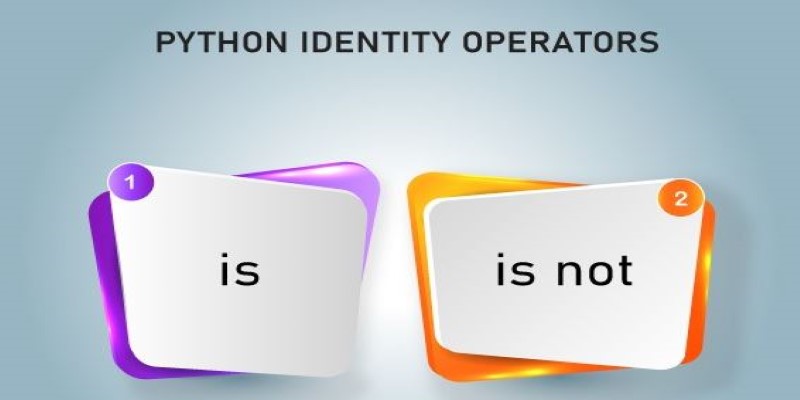When writing Python code, you often come across situations where you need to check if a value exists in a sequence or if two variables refer to the same object. These kinds of checks are more common—and more important—than they might seem at first glance. That's where membership and identity operators come into play. These aren't flashy tools, but they do a lot of the heavy lifting in everyday programming. They're clean and direct and help your code stay readable. Let's look closely at what these operators do, how they behave, and where they fit into regular coding tasks.
Membership Operators: in and not in
Python’s membership operators are used to test for presence — whether a value exists within a sequence or collection like a list, tuple, set, dictionary, or string.
How it Works
The operator checks if the left-hand value appears in the right-hand collection. If it does, it returns True. Otherwise, you get False.
python
CopyEdit
colors = ['red,' 'green,' 'blue']
'green' in colors # True
In this case, 'green' is part of the colors list, so the condition is true.
It works with strings, too:
python
CopyEdit
sentence = "Learning Python is fun"
'Python' in sentence # True
And with dictionaries, it checks for the presence of keys, not values.
python
CopyEdit
user = {'name': 'Alice,' 'age': 30}
'name' in user # True
'Alice' in user # False
So, remember — with dictionaries, the keys are always considered during a membership check.
What About not in?
This is just the opposite. If the value isn't present in the sequence or collection, it does not return True.
python
CopyEdit
'purple' not in colors # True
Again, clean and predictable.
Identity Operators: is and is not.

Now, let's shift focus to something that catches many beginners off guard — identity operators. These don't check whether two variables look the same. They check if they are the same object in memory.
Understanding is
When you use it, Python checks if both variables point to the exact same object. It's not about value equality — it's about identity.
python
CopyEdit
x = [1, 2, 3]
y = x
x is y # True
Here, both x and y refer to the same list object in memory. They are identical in that sense.
Now look at this:
python
CopyEdit
a = [1, 2, 3]
b = [1, 2, 3]
a is b # False
Even though a and b contain the same values, they’re stored separately. That’s why a is b is false, even though a == b would be true.
This kind of check is useful when you’re working with singletons or comparing objects where identity matters more than content.
Using is not
It’s simply the inverse.
python
CopyEdit
a is not b # True
This operator is often used when you want to make sure a variable doesn't refer to something specific, like None.
python
CopyEdit
if the value is not None:
# proceed
This is better than writing value != None because it is None, which is both faster and more precise in intent.
Comparing Membership vs. Identity
Although both types of operators involve comparisons, they operate on very different levels. Membership checks look inside collections to see if a value exists. Identity checks don’t care about the content — they only care whether two variables refer to the exact same object in memory.
That means this kind of code can give very different results depending on the operator used:
python
CopyEdit
name1 = "Bob"
name2 = "Bob"
name1 == name2 # True
name1 is name2 # Might be True, but don't count on it
In Python, small strings and integers are sometimes cached, so it might return True — but that's an implementation detail. If you're comparing content, use ==. The only use is if you're checking identity on purpose, like with None.
Where These Operators Come in Handy
It’s one thing to know how they work — it’s another to see where they’re useful. These are a few practical places where they tend to show up.
Cleaning Up Input
Suppose you're taking user input and want to validate whether it contains certain keywords.
python
CopyEdit
blacklist = ['spam,' 'ads,' 'clickbait']
text = "This article contains no spam."
if any(word in text for word in blacklist):
print("Content flagged.")
Here, membership is doing the filtering work.
Validating NoneType

Let’s say a function may or may not return a value. You can check identity with None to keep things clean.
python
CopyEdit
result = get_value()
if the result is None:
print("We have something to work with.")
This avoids the pitfall of accidentally matching 0, '', or False, all of which are valid values but not the same as None.
Avoiding Duplicates
Membership helps make sure you’re not adding repeated items to a collection.
python
CopyEdit
seen = set()
for an item in items:
If item not in seen:
seen.add(item)
It’s a lightweight check that prevents duplication without needing nested loops.
Singleton Comparisons
Identity checks really shine with singletons. Besides None, some design patterns use single objects to represent default states, which makes those comparisons clear.
python
CopyEdit
SENTINEL = object()
def fetch_value(source):
return source.get('key', SENTINEL)
result = fetch_value(my_source)
if the result is not SENTINEL:
# process result
This is a pattern you’ll come across more often in production code than in tutorials.
Conclusion
Python’s membership and identity operators do quiet, behind-the-scenes work that keeps your logic tight and your code readable. Whether you're scanning lists for specific values or making sure you're not dealing with None, these tools help you express those intentions clearly. And the more you write, the more second nature they become — without needing anything complicated to get there. Hope you find this info worth reading. Stay tuned for more interesting yet useful guides.











